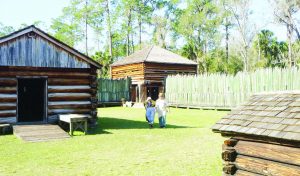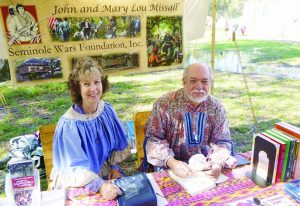By James C. Fulmer | Past President, NMLRA
“Time is really the only capital that any human being has, and the only thing he can’t afford to lose.”
—Thomas Alva Edison
Time: what a big word! It means so much to so many different people. Now that I am retired you would think there would be more time. But in reality there has become less. What is down that road? What is around the next bend or what is written on that roadside marker?

Inside Ft. Foster: to the left is a supply house; the center blockhouse and powder magazine are to the right.
I went to Florida in January to the Alafia Rendezvous, and afterwards I stayed in several campgrounds in central Florida until the end of February. I kept busy chasing roadside markers and historical sites. I am always amazed about how little I know about history.
On the way to the beach I spotted a roadside marker “Gamble Plantation Historic State Park” this way. That is how time starts to slip away; the further you look the more interesting something becomes and deserves more time. The Gamble Plantation Mansion is the only surviving antebellum mansion in south Florida. I learned a lot at the museum at the plantation about Gamble’s history but also the history of Florida.
In 1843 Major Robert Gamble Jr. would claim 160 acres along the Manatee River that was promoted by the Armed Occupation Act. You had to live on the ground for 5 years; it would take him over 6 years to build his Mansion. This Act of Congress passed after the Second Seminole War (1836-1842) removed many Native Americans from Florida. Major Gamble would eventually build the plantation house and acquire over 3,500 acres to add to the original free 160 acres. It would become a large sugar plantation but due to natural disaster and a bad sugar market he had to sell out in 1859.
During the Civil War the Mansion became the home of Capt. Archibald McNeill, a famous Confederate blockade runner. At the end of the Civil War in 1865 the US Government ordered all Confederate Cabinet members arrested. Judah P. Benjamin was the Confederate Secretary of State. Fearing he would be tried for treason he escaped to Florida and made his way to the Gamble Mansion and Capt. McNeill. It is said that Judah Benjamin with help would escape to the Bahamas in April 1865 and then all the way to England. There he would eventually become a barrister or lawyer and 1872 would be selected as Queen’s Council.
In 1925 the Mansion was in shambles and the United Daughters of the Confederacy purchased the property and deeded it to the State of Florida. If I hadn’t read the road sign and have an interest in history I would have never visited the Mansion on the Manatee. But what sparked a curiosity was the brochure that read “Following the Second Seminole War (1836-1842).” I only really knew of that one war with the Seminoles.
While I was at the Alafia River Rendezvous in Florida many people at the event told me I would enjoy going to Fort Foster which is located on the Hillsborough River near Thonotosassa, FL. Fort Foster was built during the Seminole wars to defend a bridge which crossed the river and also was used as a re-supply point for the soldiers in the field. There was to be a Rendezvous held at Ft Foster Historic Site Feb 9-10, 2019. I had the opportunity to attend so I went to try and learn more about the “Second Seminole War’. I was not disappointed in my visit to the site.
Recreated forts such as Ft. Foster are a great way you can visualize and imagine what it was like to be garrisoned in the fort. Early in the war a bridge was built over the Hillsborough River and left undefended. The bridge was promptly burned by the Seminoles and when Major Francis Dade led a troop of 108 men from Ft. Brooke, located on Tampa Bay, over the Ft. King Military Road to Fort King they were delayed several days because of the destroyed bridge. They would be all killed but three 25 miles south of Fort King (modern day Ocala) by the Seminoles on Dec. 28, 1835. That spring in March 1836 Fort Alabama was built at the crossing site. It would be attacked several times by the Seminoles between March and April but the attacks were unsuccessful. On April 26, 1836, after only two months of its construction, Fort Alabama was abandoned. But on Nov. 28, 1836, Lt Col. William S. Foster received orders to rebuild the fort and bridge over the Hillsborough River. The fort would be given his name. Later he would build another similar fort and bridge over the Withlacoochee River.
By June of 1838 the fort was abandoned again as the Seminoles where pushed further south in Florida. The official end of the Second Seminole war was Aug. 14, 1842.The second Seminole war was the most costly Indian war in United States history, costing $35 million dollars. Fort Foster was used again briefly in 1849 when it appeared the Seminoles would again go to war.

Mary Lou Missall and John Missall are the authors of several books about the Seminole Wars.
Walking around the fort during the rendezvous there were many living history re-enactors and vendors that had period correct items for sale. There were several artillerymen dressed in 1830s time uniforms manning the 6-pounder field piece and the 12-pounder howitzer giving demonstrations. The .69-cal. 1816 Springfield flintlock musket was the firearm used at that time period and I saw several carried by re-enactors at this event.
By attending this event, I probably ran into some of the most of knowledgeable people about the Seminole wars; John and Mary Lou Missall were two of those people. John and Mary Lou are both authors whose primary focus is the Seminole Indian Wars. They have written many books and novels about the Seminole Wars. They had them for sale as a vendor, and I being bluntly honest asked, “Which is the best book for somebody who doesn’t know anything about the Wars?” They recommended me to get “The Seminole Wars: America’s Longest Indian Conflict,” which I bought and it is a great book. It covers all three of the Seminole Wars 1817-18, 1835-42, and 1855-1858. Early on in the book, the wars were a gradual progression from a Spanish colony to a US Territory, to a state.
The book has a lot of history I didn’t know and one was that Col. Zachary Taylor on Christmas Day 1837 was in command at the Battle of Lake Okeechobee. This was to be the largest battle of the Seminole War. The United States Army suffering heavy casualties but still where able to drive the Seminoles across the lake and made Zachary Taylor an instant hero. Calling the battle a victory was only technically correct. But the American people wanted some good news from the war and Taylor gave it to them and was promoted to Brigadier General and national fame. He would go on to become the 12th president of the United States.
What I have learned is that history is a study of the past events that could have happened yesterday, or all the way back to antiquity. It is up to you to recognize what is important, so you can grow with the future.



